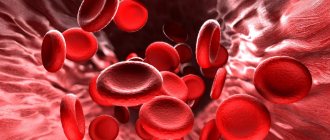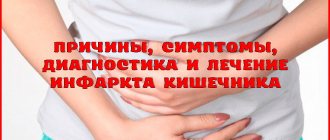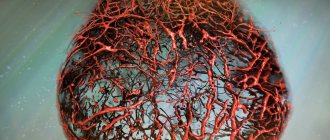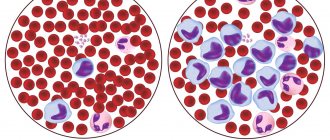Causes and pathogenesis
As mentioned above, the direct cause of the disease has not been identified to date. However, there are a number of theories about this.
- Infectious theory (not confirmed by in-depth study).
- Hereditary theory, including the theory of the multifactorial nature of the disease.
- Theory of impaired metabolism, immune dysfunction (autoaggression of the body).
- Hypothesis about dysfunction of the autonomic nervous system.
- Theory of endocrine disorders.
With a careful study of the pathogenetic processes underlying the formation of limited scleroderma, one can see that almost every hypothesis is reflected in it. But the main role is given to autoimmune disorders.
In its development, localized scleroderma goes through three successively alternating stages - swelling, hardening and atrophy. The first lasts several weeks and is often unnoticeable. The skin becomes smooth, shiny, and tense. Its density and consistency changes – it becomes doughy in nature. Color varies from normal to reddish-bluish.
After the edema stage, the pathological process quickly moves into the compaction stage. The skin becomes colder, becomes dense, does not move, does not fold. Around the affected area there is a bluish rim (an area of peripheral growth), while the area itself is waxy-pale or dirty-gray in color.
The last stage is atrophy. The skin of the affected area becomes thinner. Takes on the appearance of parchment paper. Fatty tissue and muscles may be involved in the process. In this case, the skin is adjacent directly to the bone structures.
Possible consequences of scleroderma
The consequences that arise as a result of the lack of treatment for the disease include:
- Scleroderma changes (abscesses, wrinkles);
- Hyperemia of the skin;
- Trophic changes;
- The appearance of a vascular pattern that is localized on the skin;
- Chronic conjunctivitis;
- Pharyngitis;
- Rhinitis;
- Raynaud's syndrome.
Diagnosis and treatment are made only by a doctor. Do not self-medicate, this leads to a worsening of the condition and the development of complications that cannot be cured even by the most experienced doctors.
Doctor: Olga Shishkina ✓ Article checked by doctor
Symptoms
Focal scleroderma has a different clinical picture and symptoms, depending on the form. In this case, one person may experience a combination of several types of the disease. But let's consider each case separately.
Plaque scleroderma is the most common type of pathology. It occurs mainly in middle-aged women (30-50). As with other options, three processes successively change in the skin - swelling, thickening, atrophy. It is characterized by the appearance of zones of erythema and thickening (induration) on various parts of the body (head, torso, limbs).
Often the affected areas are caused by trauma and compression of the skin (tightened belt, belt, tight bra). First, round or oval spots of a pink-purple hue appear, somewhat swollen. They slowly increase in size (from several to 20 cm), with progressive thickening of the skin in the center. At the periphery, the pink-lilac corolla remains. The affected skin gradually turns pale (ivory color) and becomes smooth (the skin pattern is erased).
Subsequently, the corolla on the periphery disappears, and is replaced by spider veins and pigmentation. The skin becomes thinner and folds again. With timely treatment, the process can be reversed. The appearance of hyperpigmentation of the affected area is a good prognostic sign.
Plaque scleroderma can be in the form of:
- morphea (foci) – described above;
- nodules (keloid-like) – one or more sclerotic areas appear on the body in the form of nodules that resemble keloid scars;
- Pasini Pierini atrophoderma is a mild, superficial variant of plaque scleroderma. It occurs in girls aged 10-20 years with the predominant localization of pathological lesions on the back.
Linear scleroderma (stripe-shaped) - foci of pink-bluish color that appear on one side of the body or along the neurovascular bundle (Zakharyin-Ged zone), often on the head or limbs, have a linear shape. It occurs more often in childhood and can be combined with Parry-Romberg hemiatrophy.
The formation of a scleroderma lesion goes through three known stages. Most often, a single lesion spreads from the scalp to the face, reminiscent of a saber strike.
White spot disease (lichen sclerosus, guttate scleroderma) - the affected areas are represented by small (3-10 mm) pearlescent whitish spots, shiny plaques. The lesions may merge and have scalloped, clear edges. Around there is an erythematous corolla. Skin in the atrophy stage resembles crumpled papyrus paper. Frequent locations are neck, shoulders, upper chest.
Hemiatrophy of the face - focal scleroderma in this case begins in adolescence (20 years). It is equally common in men and women. The face is affected, most often the process begins with the capture of the area around the eyes, cheekbones and lower jaw. In this form, the underlying structures of the skin – fatty tissue and muscles – are primarily involved in the process. Patients experience pain, chewing processes and speech are disrupted.
Forecast
The prognosis for focal scleroderma is favorable if the entire course of medication is completed and medical recommendations are followed exactly. Also, much depends on the form and degree of neglect of the disease: the prognosis for a widespread pathology detected late is unfavorable - there is a risk of transformation of a local variety into a systemic one.
Mild forms of scleroderma are easy and become complicated only in the absence of treatment, so at the first symptoms of the disease you should consult a dermatologist and undergo diagnostics.
Which doctor treats focal scleroderma?
Since focal scleroderma is characterized by predominantly skin lesions, a dermatologist should deal with this pathology. But to exclude systemic damage and differential diagnosis with other autoimmune diseases, consultations with a therapist and rheumatologist are necessary. Also, to identify concomitant pathologies and decide on further treatment and eliminate severe deformities, the attending physician may order examinations:
- ophthalmologist;
- gynecologist;
- endocrinologist;
- surgeon;
- neurologist.
Forecast and prevention of the disease
Is scleroderma dangerous?
The prognosis for the disease is almost always favorable. With timely treatment, the disease can be completely cured without leaving any traces. If left untreated, it may progress
Prevention comes down to timely detection and treatment of hormonal and autoimmune diseases. It is necessary to avoid hypothermia of the body; hands should always be warm.
Don't forget about the possible harmful effects of the sun. If there is a genetic predisposition to scleroderma, it would be a good idea to visit your doctor every year and carry out the necessary diagnostics.
Diagnostics
The diagnosis is made based on the history and clinical picture. The following are used as additional means to confirm the diagnosis:
- Blood test (general, biochemical).
- Immunological blood test (detection of antinuclear antibodies, rheumatoid factor, antibodies to the cells of the body’s own body, study of Ig levels).
- Analysis of urine.
- Histological examination of the skin (if necessary).
- Ultrasound of the abdominal organs, kidneys, thyroid gland.
- ECG.
- X-ray of the chest, skull bones.
- Encephalography.
- CT.
- MRI.
Why do such violations occur?
The reasons for the development of scleroderma are still debated. The main theory is about genetic predisposition to the disease. According to research results, 90% of patients with this pathology have abnormalities in the chromosome structure. However, some patients who have everything in order with their genes do not allow us to say that scleroderma is 100% hereditary disease.
Complex forms of the disease are associated with disturbances in the functioning of the immune system. According to this theory, the body begins to produce antibodies against its own vascular epithelial cells.
Most patients have certain disturbances in the functioning of the endocrine system. Scientists associate the pathology partly with diseases of the pancreas, and partly with pathologies of the thyroid gland.
Superficial forms of the disease, in which only the skin is affected, are considered to be a consequence of chronic damage to the epidermis. People who work with pesticides, organic solvents and other harmful chemicals are prone to the disease.
Neurologists claim a direct connection between scleroderma and stress. Psycho-emotional stress and severe shocks often become a trigger for the development of pathology.
Treatment
Treating limited scleroderma is a difficult task. You cannot cope with it on your own; control and supervision of a specialist is necessary. In this case, treatment should be comprehensive and long-term, selected taking into account the characteristics of each individual patient.
Limited scleroderma is treated in three ways - drug therapy, physical therapy and surgery.
Firstly, it is necessary to cure or put into remission (if cure is not possible) chronic diseases and change lifestyle.
In parallel, efforts are being directed towards eliminating scleroderma itself. In the active stage, a stationary regimen is recommended. Among medications for scleroderma, those that improve microcirculation and have an immunosuppressive effect are used:
- Penicillin.
- Cuprenil.
- Methotrexate.
- GCS (prednisolone).
- Theoniol, nicotinic acid, pentoxifylline.
- Lidaza (im or subcutaneously) and other absorbable agents (trypsin, hyaluronidase).
- Unithiol.
- Vitamins (A, E, group B).
- ATP.
- Local remedies - topical corticosteroids (Betamethasone in the form of cream or ointment, Aclometasone, etc.).
Physiotherapeutic methods for treating limited scleroderma include UVA irradiation, PUVA therapy, ultrasound, laser, gymnastics and massage.
Surgeries for scleroderma are performed according to indications in case of formation of contractures and limitation of motor function of joints.
How to treat?
Medicines occupy the main place in the treatment of scleroderma. Traditional medicine methods can only complement therapy, but not replace it.
Treatment with medications
The list of drugs prescribed to the patient depends on the involvement of various organs and the severity of the disease.
To treat skin processes, the following are used:
- At the initial stage, inflammation can be relieved by using glucocorticosteroids in local forms, which lubricate the areas of inflammation on the skin.
- In the stage of sclerosis, medications that can resolve scar tissue (Contractubex and analogues) can help. Unfortunately, most often it is not possible to completely get rid of skin manifestations.
- Cosmetic creams with a softening effect, which are applied to the skin three times a day, help symptomatically.
Possible drugs for systemic scleroderma:
- Vascular agents - nifedipine, bosentan, pentoxifylline, Vasoprostan, sildenafil.
- Immunosuppressants - hydroxychloroquine, D-penicillamine, prednisolone in low doses.
- Renal drugs - ACE inhibitors and angiotensin receptor blockers.
- Omeprazole and its analogues help treat symptoms of dyspepsia in gastrointestinal tract lesions.
- Damage to joints and muscles is treated with methotrexate, prednisolone and other immunosuppressants.
- Situationally, non-steroidal painkillers can be used for pain.
Arbidol for autoimmune disease
Arbidol is an antiviral drug that is used for influenza and ARVI. This remedy does not help treat autoimmune diseases.
The drug can be used for the prevention and treatment of respiratory diseases in scleroderma; this drug does not have the ability to change the activity of the immune system.
Folk remedies
Therapy with folk remedies for systemic forms of scleroderma is absolutely unproven and even harmful. It is contraindicated to influence immunity in this disease.
Some traditional healers recommend treatment using the Hijama method, can it be used for systemic scleroderma? This method involves bloodletting and stimulates local blood circulation. It will not cure autoimmune disease, but it has a symptomatic effect in some patients. It is recommended to consult a specialist before performing such a procedure.
You can relieve swelling and inflammation on the skin using folk remedies. For this purpose the following are used:
- Aloe juice.
- Decoctions of lungwort and horsetail.
- Compresses with lingonberries, raspberries and plantain.
- Badger fat in the form of local applications.
Do not replace the main therapy with the listed remedies.
The use of immunomodulators for scleroderma not only does not help, but is also dangerous.
Diet
Proper nutrition helps normalize the functioning of the body and get rid of some symptoms of the disease. Adhere to the following rules:
- Maintain a normal body weight and eat small, frequent meals.
- Avoid smoking and drinking alcohol completely.
- Vegetables and fruits contain antioxidants and reduce inflammation.
- Mushrooms, brown rice, and foods rich in vitamin C support human immunity.
- Carrots, pumpkin, plums, and sea fish saturate the body with vitamin A.
- Vitamin E, which is found in nuts, vegetable oils, buckwheat and oatmeal, also has antioxidant properties.
- Vitamin D helps strengthen the musculoskeletal system and reduces inflammation. It is found in fish and eggs and should be consumed together with calcium, which is found in cottage cheese and milk.
- You should not eat large amounts of fried and fatty foods; canned foods and processed foods are also dangerous.
Traditional therapy
Focal scleroderma is a serious disease that cannot be cured without the use of a whole range of measures, including medications. But decoctions of medicinal herbs can be used as aids.
Among the plants that have a beneficial effect on scleroderma, you can use hops, lemon balm, oregano, St. John's wort, motherwort, calendula, and horsetail. To use, the mixture of dry herbs is poured with boiling water (a glass of water per tablespoon of the mixture), infused for 2-3 hours and taken 1/5 cup 3 times a day half an hour before meals. Before use, consultation with your doctor is required to prevent allergic and other adverse reactions.
Causes of the disease
The exact cause that can trigger the appearance of scleroderma is unknown, but there are theories about the origin of the disease. Hereditary predisposition to the disease is the most current theory, according to which scleroderma occurs only with genetic defects that activate the disease when provoking factors appear. With scleroderma, increased collagen synthesis occurs, and at the same time, connective tissue is destroyed by triggering immune reactions. Inflammation occurs with a predominance of proliferation of fibrous tissue against the background of degenerative changes.
Provoking factors include:
- Vaccines and medications with high allergenic properties.
- Infectious diseases, especially RNA-containing and slow retroviruses, which can remain in the body for a long time, provoking an autoimmune process.
- Any connective tissue diseases that are inherited.
- Hypothermia, exposure to ultraviolet radiation and injuries to the musculoskeletal system.
- Hormonal disorders, including physiological processes (childbirth, menopause).
Main dangers
With timely diagnosis, the pathology does not pose any danger to human life. It can only develop cosmetic imperfections that can be removed through cosmetic and dermatological procedures.
Pathology if treatment is not provided can lead to:
- to the formation of dark spots on the skin,
- to the appearance of vascular networks,
- provoke chronic Raynaud's syndrome, which occurs due to disturbances in microcirculation. It is described by the fact that in the cold a person begins to experience severe pain in the limbs and fingers, and at the same time the skin in such areas becomes very pale. When warmed up, the pain stops, the fingers become purple in color, and then change to the usual purple hue.
Scleroderma is considered a serious disease in the patient’s connective tissue, regardless of the type of manifestation. But with the right approach to therapy, and most importantly to the prevention of the disease, the development of pathology and severe symptoms can be avoided.











